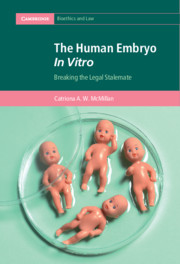Book contents
- The Human Embryo In Vitro
- Cambridge Bioethics and Law
- The Human Embryo In Vitro
- Copyright page
- Dedication
- Contents
- Foreword
- Acknowledgements
- Table of Cases
- Table of Legislation
- Abbreviations
- Introduction
- Part I Into Liminality
- Part II Through Liminality
- 4 Navigating Legal Purgatory
- 5 A Liminal Lens
- Part III Out of Liminality
- Bibliography
- Index
4 - Navigating Legal Purgatory
The Otherness of Embryos
from Part II - Through Liminality
Published online by Cambridge University Press: 18 March 2021
- The Human Embryo In Vitro
- Cambridge Bioethics and Law
- The Human Embryo In Vitro
- Copyright page
- Dedication
- Contents
- Foreword
- Acknowledgements
- Table of Cases
- Table of Legislation
- Abbreviations
- Introduction
- Part I Into Liminality
- Part II Through Liminality
- 4 Navigating Legal Purgatory
- 5 A Liminal Lens
- Part III Out of Liminality
- Bibliography
- Index
Summary
This chapter draws parallels to the gothic trope that surrounded discussions on embryos in vitro in the 1980s as a frame of analysis that has grown in counter-response to law’s tendency to place entities either within the category of a ‘liberal, individual self,’ or outwith it (rarely in between). To explain, the gothic self is characterised by disorder, chaos, and dependency. It cannot be subsumed under the traditional ‘self’ that the law presupposes of its subjects. Further, within ‘the gothic’ lies the key concept of ‘monstrosity’, at the margins of what we deem to be human: ‘we stake out the boundaries of our humanity by delineating the boundaries of the monstrous’. While the gothic trope does not explicitly centre around ‘the in between,’ it is argued that we should see gothic entities as such, because of their common placement - legally, and sometimes socially - on the boundary between liberal, individualised human, and something akin to a science-fiction-esque ‘monster.’ The controversy that causes rhetorical parallels between new research and monstrous beings and mad scientists to be drawn is a major contributor to policy-makers reluctance to revisit the legal status of embryos in vitro.
- Type
- Chapter
- Information
- The Human Embryo In VitroBreaking the Legal Stalemate, pp. 99 - 116Publisher: Cambridge University PressPrint publication year: 2021

